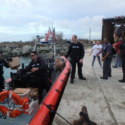YouTube news vlogger Philip DeFranco recapped Puerto Rico’s situation in a recent video. Watch to catch up on the situation in Puerto Rico and the U.S. government response to the destruction of Hurricane Maria.
There have been some changes since this video was made. The White House has waived the requirement for matching funds from the territory’s government for 180 days. This means that almost six months of disaster response will be paid for completely by the federal government. The Jones Act has also been waived temporarily.
The USN Comfort, the floating trauma center described in the video, has now been sent to Puerto Rico. Fuel has been sent to 200 gas stations and 19 hospitals, the White House reports, so getting needed food, water, and medical supplies to people in remote areas should become easier. The Department of Defense and the Coast Guard are pitching in, and donations are pouring in.
More help is needed — and perhaps equally importantly, a forward-thinking strategy is needed.
“Current efforts are not sufficient.”
Author and attorney Yasmin Tirado-Chiodini, a former Space Shuttle engineer, wrote this:
The current disaster relief efforts by FEMA are not sufficient. The logistics of the operation to deliver food, water, supplies, and fuel throughout the island has proven unfruitful to date. Aside from the roads being compromised, there are not enough drivers to pick up the cargo from San Juan and deliver it throughout the island. To date, there are 3K cargo containers sitting in the Port of San Juan since last week with no-one available to unload and deliver them. We need alternative distribution channels, including planes, boats and access to other ports for distribution to the central and western part of the island, most of which has remained isolated even a week after the hurricane decimated the island.
Congress must include emergency supplemental appropriations funding for Puerto Rico, and the US Military humanitarian campaign in the island must be of a much larger scale, consistent with the impending humanitarian need our island is facing. Anything less would be irresponsible, immoral, and inhumane. Limiting the disaster response will also lead to a national security issue, as crime and civil unrest will undoubtedly skyrocket, due to the lack of basic necessities. This is already occurring.
In addition to the need for an enhanced military humanitarian campaign and the ongoing FEMA disaster relief efforts, any legislation to assist Puerto Rico during this critical time, should include:
a) Immediate emergency disaster relief funding,
b) Critical infrastructure, housing and energy investments,
c) Federal health care funding parity, and
d) Economic tools to expedite the recovery and make Puerto Rico self-reliant over time.The 3.4 million US Citizens of Puerto Rico are suffering a catastrophe never before seen in the modern history in the island. The 5 million Puerto Ricans constituting the diaspora are up in arms, suffering for their families and friends in the island, Most of them have not been able to communicate with their loved ones to date.
Both DeFranco and Tirado-Chiodini are working to make people aware of the plight of Puerto Rico… and of the fact that Puerto Rico is at a crossroads. The United State has a responsibility to help Puerto Rico. The choices made now in Washington can set Puerto Rico on a path to future strength, or allow the Island to slip into a humanitarian crisis.
Preparation and response
This is an opportunity for Puerto Rico to rebuild with a view to the future. Puerto Rico was as prepared for this year’s hurricanes as possible, under the circumstances. The White House declared an emergency ahead of the storms, and shelters were in place.
But Puerto Rico, because it is an unincorporated territory, has received less funding for its roads and bridges over the years than states have received. Puerto Rico has been less prosperous than the states. Basic upkeep for the infrastructure has not been covered. The electric authority and water authority were not in a position to cope with hurricanes. The condition of the roads, the Port of San Juan, the airport, and the hospitals wasn’t strong enough to withstand a hurricane. This has made emergency response more difficult than it should be.
Doctors have been leaving Puerto Rico in large numbers for years. Health care facilities have complained that they don’t have the resources they need. Puerto Rico has been in a bad situation for a long time. Naturally, the Island could not cope with a hurricane as well as Texas and Florida could.
As Puerto Rico rebuilds, it should be with a view toward the future. The United States will be making an investment in Puerto Rico. The United States owns Puerto Rico, and there is no possibility of ignoring an island inhabited by 3.4 million U.S. citizens. Puerto Rico’s destruction gives the U.S. the chance to do the right thing, rebuilding the struggling territory as a modern U.S. state.
Use the Sound Off widget to the right, email your legislators, or express yourself in a tweet directed toward your congressional representatives. Let your representatives know that Puerto Rico needs strategic, well thought out support to put the Island on a path to prosperity.








No responses yet